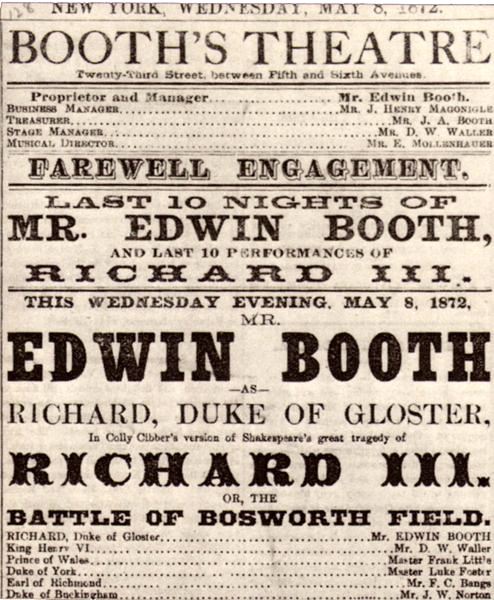
The extent to which Edwin Booth was part of the fabric on New York City social and cultural life is often lost on us today. This playbill is from 1872, seven years after his younger brother assassinated Abraham Lincoln.
Last evening I had the unique opportunity and privilege to visit The Players NYC and see Edwin: The Story of Edwin Booth. The play is what is called in preview, which means the production is almost complete and is being shown in front of a live audience to work out the final details before it makes its public opening. I found the play poignant and will not give the ending, which surprised me totally. What made the evening special, besides the company and our gracious hosts, was the setting. Edwin Booth founded The Players in 1888. The Gramercy Park brownstone had been Booth’s private residence until he hired Stanford White to renovate it as a theater and social club for actors, writers, and artists. Samuel J. Tilden was Booth’s next-door-neighbor. It opened as a theater on December 31, 1888. Throughout the house was memorabilia from the club’s long history. Original members included William T. Sherman, Horace Porter, Mark Twain, and Elihu Root. That gives you an idea of the circles in which Booth mingled.

Members of The Players NYC who have enjoyed this Gramercy Park view have included Pete Hamill, Laurence Olivier, William T. Sherman, Dwight Eisenhower, Frank Sinatra, Humphrey Bogart, and Morgan Freeman.
After the play our host took us to see some areas open to members-only. This included the one-room space in which Booth resided. It remains exactly as it was when he died. Propriety–unfortunately–prevented me from taking pictures. The sense of history was palpable. There was a large photograph of Edwin and John Wilkes’s booth father which was decorated with a black mourning ribbon common in Victorian times. There was so much else besides. I find it comforting that some remnants of Old New York are still here today in the twenty-first century. Thank you again to those who made such a memorable night possible.

What a wonderful experience !
The Players NYC is a special place. It was neat to be there on the 150th anniversary of the end of the war. That was why they held it there.
It’s early, but Sox looking good…